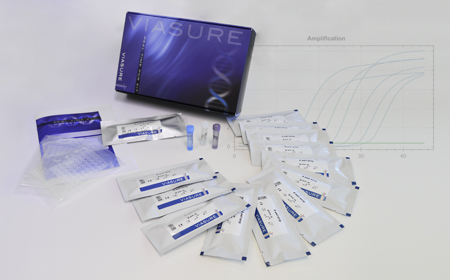
VIASURE Real Time PCR Detection Kits
E. coli ETEC + EIEC

Description
VIASURE E. coli ETEC + EIEC Real Time PCR Detection Kit is designed for the specific identification and differentiation of Enterotoxigenic E. coli (ETEC) and Enteroinvasive E. coli (EIEC)/Shigella in human stool samples from patients with signs and symptoms of gastrointestinal infection.
This test is intended to be used as an aid in the diagnosis of ETEC and EIEC/Shigella in combination with clinical and epidemiological risk factors.
DNA is extracted from stool specimens, multiplied using Real Time amplification and detected using specific primers and a fluorescent reporter dye probe for ETEC and EIEC/Shigella.
Specifications
Information
Escherichia coli is (E. coli) a gram-negative microorganism that can be an innocuous resident of the gastrointestinal tract, but it also has the pathogenic capacity to cause enteric disease, and extraintestinal diseases, as urinary tract infections (UTIs) and sepsis/meningitis. Pathogenic variants of E. coli (pathovars or pathotypes) cause much morbidity and mortality worldwide, due to they have low infectious doses and are
transmitted through ubiquitous mediums, including food and water. Of the strains that cause diarrhoeal diseases, six pathotypes are now recognized: Enterohaemorrhagic E. coli (EHEC), Enterotoxigenic E. coli (ETEC), Enteroinvasive E. coli (EIEC), Enteropathogenic E. coli (EPEC), Enteroaggregative E. coli (EAggEC), and Diffusely adherent E. coli (DAEC). Furthermore, different E. coli strains may belong to more than one pathotype group owing to the expression of different virulence factors.
Enterotoxigenic E. coli (ETEC) colonizes the surface of the small bowel mucosa and induces watery diarrhoea by the secretion of heat-labile (LT) and/or heat-stable (ST) enterotoxins. These enterotoxins cause inhibition of sodium absorption and stimulation of chloride secretion, which leads to watery diarrhoea. Abdominal cramps, sometimes with nausea and headache, occur and fever is usually absent. ETEC is a major cause of traveller’s diarrhoea worldwide and and endemic in most underdeveloped countries with significant mortality rates in children. ETEC infections are also transmitted through the fecal-oral route, when a person ingests food or water contaminated.
Enteroinvasive E. coli (EIEC) are biochemically, genetically and pathogenically closely related to Shigella spp. Both bacteria express the invasion plasmid antigen H (ipaH) gene which is related to invasion. There are four Shigella species responsible for human disease (S. dysenteriae, S. flexneri, S. sonnei and S. boydii), which cause varying degrees of dysentery. This infection is characterized by fever, abdominal cramps and diarrhoea containing blood and mucous. Severe shigellosis complications are often associated with the Shiga toxinproducing serotype S. dysenteriae 1 and can range from local intestinal disorders to systemic manifestations. Instead, EIEC might cause an invasive inflammatory colitis, and occasionally dysentery, but in most cases EIEC elicits watery diarrhoea that is indistinguishable from that due to infection by other E. coli pathogens. Conventional transmission of EIEC and Shigella is mediated via the fecal-oral route mainly through contaminated food or water or direct person-to person spread.
The adoption of molecular techniques has allowed for more rapid detection and identification of the different E. coli pathotypes. Thus, it provides the critical information for determining appropriate therapies for patients with suspected E.coli infections and controlling of the outbreak.
